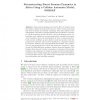Free Online Productivity Tools
i2Speak
i2Symbol
i2OCR
iTex2Img
iWeb2Print
iWeb2Shot
i2Type
iPdf2Split
iPdf2Merge
i2Bopomofo
i2Arabic
i2Style
i2Image
i2PDF
iLatex2Rtf
Sci2ools
ACRI
2004
Springer
2004
Springer
Reconstructing Forest Savanna Dynamics in Africa Using a Cellular Automata Model, FORSAT
Large areas of savannas are found in Africa in climatic zones favourable to humid tropical forests: they are relicts of past dry periods and forest domains are naturally expanding. Men have influenced the transgression, especially by starting savanna fires. FORSAT is a stochastic cellular-automaton model dedicated to the forest-savanna mosaic on a landscape scale, taking into account savanna fires, vegetation succession cycle (vegetation types are discriminated by their ecological function: herbs, pioneer seedlings, pioneer adults, forest) and pionneer seed dispersal and recruitment. The model is validated by comparison between its emergent behavior and biogeographical field studies. Two parameters (an environmental factor and a man-related fire frequency) control an van-der-Waals-like phase transition between forest and savanna. This brings to three types of evolution: progression or regression of forest edge, formation and coalescence of clumps in savanna and global afforestati...
| Added | 30 Jun 2010 |
| Updated | 30 Jun 2010 |
| Type | Conference |
| Year | 2004 |
| Where | ACRI |
| Authors | Charly Favier, Marc A. Dubois |
Comments (0)

